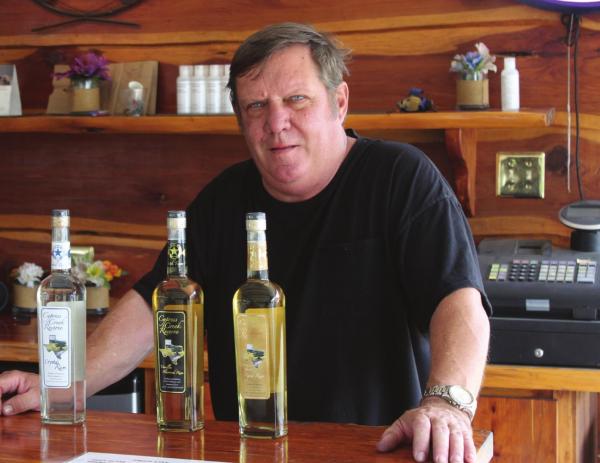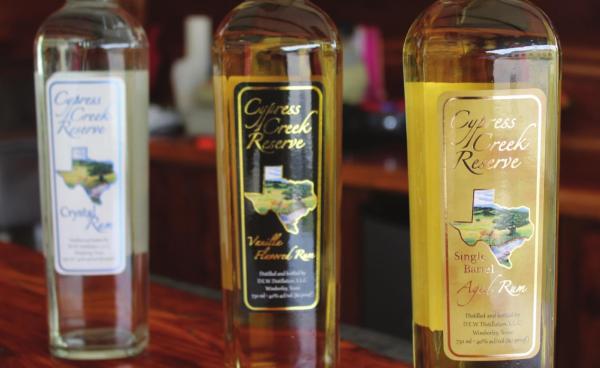The spirit behind the rum
Sometimes life throws you a curve.
A few months ago David Watson was happily producing his Cypress Creek Reserve rum at his distillery on Jacobs Well Road. Customers would stop by for a mojito or a rum and Coke on the raised deck. He was giving tours and tastings. He was doing what he wanted to do.
Of course, all that has changed thanks to COVID-19. These days, the bar is closed and David is making hand sanitizer.
David is still selling his rum — light, dark and vanilla flavored — from the distillery and it’s available at liquor stores in the area. But things are a lot quieter now.
The Cypress Creek rum is a labor of love for David and his wife Laura. A retired old-field welder, David built much of the distillery and the tasting room himself. The rum is his recipe, perfected through trial and error and extensive research. Laura handles the paper work — not an easy job with the state, county and federal governments all involved and wanting their share of the taxes collected.
David first became fascinated with rum in 2000 while on a SCUBA-diving trip to the small Indian Ocean island of Mauritius. He loved the rum there and flirted with the idea of importing it into the United States.
Do it yourself
“I thought I could do this myself,” says David. “I had the idea of importing it and just decided I’d make it. I started doing the research. Importing the rum was not cost effective. It’s much more challenging, more interesting to do it myself.”
Rum goes back a long way in the Western Hemisphere, writes author Wayne Curtis in his book, “And a Bottle of Rum: The History of the New World in Ten Cocktails.” When large sugar-cane plantations sprung up in various Caribbean islands, molasses was produced as a byproduct of the sugar-refining process. It was fermented, distilled and consumed by British sailors (whose daily rum ration could be 15 ounces a day and made for some unsteady sailors) and pirates like William Kidd and Henry Morgan. It was sold to the colonists up north and shipped to Europe. In the early days it was known as “kill devil.”
Over the years rum has become more sophisticated. Writer Ernest Hemingway was known to throw back a daiquiri or four at the El Floridita bar in Havana, Cuba. Following World War II, tiki bars such as Don the Beachcomber’s and Trader Vic’s popularized the mai tai and various flaming, fruity concoctions.
Rums range from the clear, light white to a more complex aged gold rum to the heavier, more full bodied dark rum that’s good for sipping. Spiced rum — such as Captain Morgan’s, named after the above mentioned pirate — is also popular.
Rum can be made from molasses or sugar cane juice. The world’s largest rum maker is Bacardi which sells in the neighborhood of 200 million bottles a year and owns such brands as Bombay gin, Patron tequila and Grey Goose vodka.
David Watson has a ways to go to catch up to Bacardi in sales, but the flavor of Cypress Creek rum gives the Bermuda-giant a run for its money. In pre-COVID days, David would sell 3,000 bottles of rum annually.
10 years later
While the idea of making rum took hold in 2000, it took another 10 years before the first bottle was sold. “I made some stuff in those early years that was just plain awful,” he admits. “It took a couple of years.”
As a retired welder he was able to do much of the work himself. He would buy large tanks, then modify them to his needs. He built all the piping and the outbuildings, including the new raised deck where customers can kick back, sip a cold cocktail and get a breathtaking view of the Hill Country.
When he started there were only 13 licensed distillers in the state of Texas. Today, there are more than 125.
Cypress Creek rum starts out with black-strap molasses that mostly comes from southern Texas and Louisiana. Once a year a large tanker pulls in and unloads 4,000 gallons into a tank. Diluted molasses is mixed with yeast and allowed to ferment. It’s then distilled in a large still. It goes through the distillation process twice and, initially, it all comes out clear.
David buys whiskey-aging barrels, that have only been used once, to age some of the rums. The rum draws out color and flavor from the charred oak to make his darker rum. It has a more complex flavor and a bright, golden color. His production facility is lined with barrels that are slowly transforming the rum. It can age for 2 1/2 years.
He produces about six 300-gallon batches of rum a year.
To make the vanilla rum he cuts up about 13 ounces of Tahitian-style vanilla beans for every gallon of rum and puts it in a 55-gallon drum to infuse for at least six months.
“I like doing everything the old-fashioned way. There’s no hurry-up aging here. I won’t do it. I like the old-fashioned method. It makes for a better product,” David says.
Cypress Creek distillery is considered an “essential” business in these days of the coronavirus. “Basically, they decided people had to drink,” says David.
A new product
But the cocktail bar has been closed and the tourist trade has slowed. In order to survive, David started using his alcohol to make hand sanitizer.
He studied the sanitizer guidelines laid down by the World Health Organization. He has supplied local nursing homes and Wimberley EMS. “I also supply the entire high school band,” he says with a smile.
He adds a little glycerin and hydrogen peroxide to his alcohol. When first applied, the sanitizer has a pleasing, slightly rummy scent, but that quickly dissipates.
The sanitizer is available at the distillery for $5 a bottle. The rum goes for $20- $25 a bottle. Of that, the state takes about 50 cents and the federal government’s cut is $2.50. There is also a hefty biannual state and county licensing fee.
Laura makes sure all the book work is in order and the taxes get paid. “If your paperwork is flawless and you keep good records and pay your taxes, you’re good,” says David.
David’s favorite cocktail? “We do a mojito here that is sooooo good,” he says. The secret (besides the Cypress Creek rum)? Laura infuses fresh spearmint leaves, that they grow in their back yard, with the simple sugar syrup.
The mojito recipe —and more — is on the distillery’s website: www.cypresscreekreserve.com.
Cypress Creek distillery is open for bottle sales and is located at 1400 Jacobs Well Road. For information: 512-847-6874.
Cypress Creek Reserve Mojito
2 ounces of Cypress Creek Crystal rum
1/2 fresh lime, squeezed
1/2 ounce simple syrup
8 fresh spearmint leaves
Club soda
In an eight-ounce glass, combine mint leaves and a little club soda. Muddle. Add simple syrup, rum and lime juice. Fill glass with ice and more club soda. Garnish with mint.



